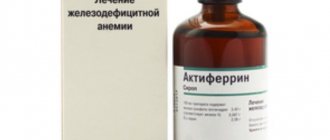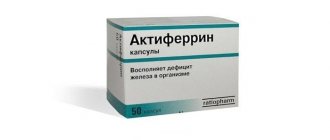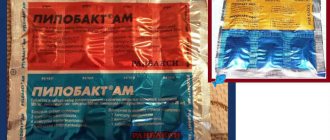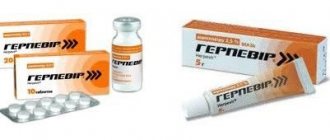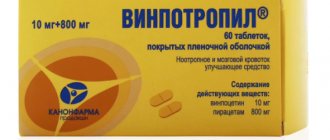Pharmacological properties of the drug Aktiferrin
A drug containing iron, necessary for the functioning of the body, which is part of hemoglobin, myoglobin, and various enzymes; reversibly binds oxygen and participates in a number of redox reactions; stimulates erythropoiesis. Iron is contained in depot tissues (bone marrow, liver, spleen). The amino acid serine, which is part of Aktiferrin, promotes more efficient absorption of iron and its entry into the systemic bloodstream, quickly normalizing its content in the body. This allows you to reduce the dose of iron, ensuring better tolerability of the drug. After oral administration, the iron contained in the drug is quite completely absorbed in the digestive tract and enters the systemic bloodstream. The maximum concentration in the blood serum is achieved within 2–4 hours after taking the drug. After absorption, it binds to the transport protein transferrin, transporting iron to the tissues, where it is released back. Excreted through the gastrointestinal tract, kidneys and sweat glands.
Indications for use of the drug Actiferrin
Iron deficiency anemia of various etiologies; latent iron deficiency in the body (without anemia), caused by excessive iron losses (bleeding, including uterine; constant donation) or increased need for it (pregnancy and lactation, period of active growth, malnutrition, certain periods of treatment for B12 deficiency anemia; chronic gastritis with secretory insufficiency, condition after gastrectomy, peptic ulcer of the stomach and duodenum, decreased nonspecific resistance of the body in adults and children with infectious diseases, tumors).
Contraindications
Absolute:
- anemia that is not associated with iron deficiency;
- iron absorption disorders (lead anemia, sideroachrestic anemia, thalassemia);
- hemolytic anemia, hemochromatosis;
- megaloblastic B12 deficiency anemia;
- aplastic anemia;
- sucrase or isomaltase deficiency, fructose intolerance, glucose-galactose malabsorption syndrome;
- age up to 6 years;
- hypersensitivity to the components of Aktiferrin compositum capsules.
It is recommended to take the drug with caution in combination with supplements and dietary products containing iron salts, as well as in pregnant and breastfeeding women (only after careful assessment of the balance of benefits for the mother and possible risks to the fetus/child).
Prescription of Actiferrin compositum iron to patients with inflammation/ulcers of the mucous membrane of the gastrointestinal tract (GIT) should be made only after assessing the ratio of the expected benefits of therapy and the increased risk of developing exacerbations of gastroenterological pathologies.
Use of the drug Aktiferrin
Actiferrin is taken orally, immediately before or during meals. The daily dose of the drug is determined depending on the level of hemoglobin, body weight and age of the patient. Capsules are taken with a sufficient amount of water. Children aged 6 to 12 years - 1 capsule 1-2 times a day, depending on the severity of the patient’s condition (34.5-70 mg Fe2+). For adults and children over 12 years of age, depending on the severity of the patient’s condition, at the beginning of treatment it is recommended to take 1 capsule 2–3 times a day (70–103 mg Fe2+); if long-term treatment is necessary, the dose is gradually reduced to 1 capsule once a day. Drops are recommended mainly for children in the first year of life up to 2 years of age inclusive. Take with a small amount of liquid (water or fruit tea). The daily dose is 3–5 drops per 1 kg of body weight (1 ml of the drug = 18 drops) 2–3 times a day. The average dose for children under 1 year of age is 10–15 drops 3 times a day (which corresponds to about 17–24 mg Fe2+ per day); for children from 1 year to 2 years - 15–25 drops 3 times a day (which corresponds to about 24–40 mg Fe2+ per day); children from 2 to 6 years old - 25–35 drops 3 times a day (which corresponds to about 40–55 mg Fe2+ per day). The syrup is recommended for use over the age of 2 years. After taking the syrup, you should drink it with a small amount of liquid (water or fruit tea). The average dose for children from 2 to 6 years old is 1/2 teaspoon (2.5 ml) 2-3 times a day (which corresponds to 34-51 mg Fe2+); for children from 6 to 12 years old - 1 teaspoon (5 ml) 2-3 times a day (corresponds to 69-103 mg Fe2+); children over 12 years of age and adults - 1 teaspoon 3 times a day (corresponds to 103 mg Fe2+). The duration of treatment with Actiferrin is 1 month. After normalization of serum iron and hemoglobin levels, maintenance treatment is carried out for another 8–12 weeks.
Release form and composition
The drug is available in the form of capsules: size No. 6, one longitudinal half is colored light brown, the other is dark brown, on the shell there is a white inscription “Aktiferrin F”; The contents of the capsule are a grayish-yellow paste with an oily consistency (10 pieces in blisters, 3 blisters in a cardboard pack and instructions for use of Actiferrin compositum).
1 capsule contains:
- active ingredients: iron sulfate monohydrate – 113.85 mg [equivalent to 34.5 mg of iron (II)], folic acid – 0.5 mg (additionally 15% excess – 0.575 mg), D, L-serine – 129 mg;
- auxiliary components: soy lecithin, rapeseed oil, hydrogenated soybean oil, partially hydrogenated soybean oil, yellow beeswax;
- capsule shell: gelatin, sorbitol, glycerol (85%), titanium dioxide (E171), iron oxide black (E172), iron oxide yellow (E172), iron oxide red (E172), iron oxide brown (E172) , white ink (shellac, butanol, ethyl acetate, methanol, titanium dioxide).
Special instructions for the use of the drug Actiferrin
When prescribing the drug Aktiferrin for a course, it is necessary to systematically monitor serum iron and hemoglobin levels. Caution should be exercised when prescribing syrup and drops to patients with diabetes, taking into account the carbohydrates included in the drug: 18 drops (1 ml) contains 64 mg of glucose, which is equivalent to 0.0053 XE, 1 teaspoon of syrup contains 1.8 g of glucose, which is equivalent 0.15 XE. To prevent the development of dark plaque on teeth, syrup or drops should not be taken undiluted; After using the drug and finishing eating, you should brush your teeth. When taking Actiferrin, stool may turn black, which has no clinical significance. If iron deficiency is established in the body during pregnancy and lactation, the use of the drug is considered justified and safe.
Aktiferrin drops 30 ml
pharmachologic effect
Iron supplement. Iron is necessary for the functioning of the body: it is part of hemoglobin, myoglobin, and a number of enzymes; reversibly binds oxygen and participates in a number of redox reactions; stimulates erythropoiesis. included in Actiferrin promotes more efficient absorption of iron and its entry into the systemic circulation, which leads to the rapid restoration of normal iron content in the body. The inclusion of serine in the alpha amino acid makes it possible to reduce the dose of iron, ensuring better tolerability of the drug.
When using the drug Actiferrin , iron deficiency in the body is quickly replenished, which leads to a gradual regression of clinical (weakness, fatigue, dizziness, tachycardia, soreness and dry skin) and laboratory symptoms of anemia.
Pharmacokinetics
Suction
After oral administration, iron is quite completely absorbed from the gastrointestinal tract. Cmax of iron in the blood serum is achieved within the first 2-4 hours after taking the drug. There is a correlation between the degree of iron deficiency and the amount of iron absorbed into the systemic circulation (the higher the iron deficiency, the better the absorption).
Removal
Excreted in urine, feces and sweat.
Indications
— iron deficiency anemia of various etiologies;
- latent deficiency of iron in the body, associated with excessive iron losses (bleeding, including uterine; constant donation) or with an increased need for it (pregnancy; lactation; period of active growth; malnutrition; chronic gastritis with secretory insufficiency; condition after gastric resection; peptic ulcer of the stomach and duodenum; decreased body resistance in adults and children with infectious diseases, tumors).
Instructions for use / dosage
Adults and teenagers
It is preferable to prescribe the drug in capsule form, at the beginning of therapy - 1 capsule.
2-3 times/day. If the drug is poorly tolerated, the dose is gradually reduced to the maximum tolerated. In this case, the duration of therapy (until hemoglobin normalizes) increases. For children over 6 years of age, Actiferrin is prescribed 1 capsule/day.
Children over 2 years old
It is preferable to prescribe the drug in syrup form.
The daily dose is 5 ml/12 kg body weight. Average doses for preschool children
are 5 ml 1-2 times/day;
for school-age children
- 5 ml 2-3 times/day.
Actiferrin to newborns and young children in the form of drops. The daily dose is set at the rate of 5 drops/1 kg of body weight; frequency of administration - 2-3 times/day. Average doses for infants
are 10-15 drops 3 times a day;
for preschool children
- 25-35 drops 3 times a day;
for school-age children
- 50 drops 3 times a day.
The drug is taken orally immediately before or during meals. Do not chew the capsules, take them with a sufficient amount of water.
Drops and syrup are taken with a small amount of liquid (fruit tea or water).
Treatment with the drug is continued for at least 8-12 weeks after achieving normal levels of serum iron and hemoglobin, prescribing a maintenance dose.
Side effect
From the digestive system:
loss of appetite, bitter taste in the mouth, flatulence, constipation, diarrhea; rarely - abdominal pain, nausea, vomiting.
Allergic reactions:
rarely - itching, rash; in some cases - anaphylactic shock.
From the side of the central nervous system:
headache, dizziness; rarely - weakness, irritability; in some cases - encephalopathy with epileptic syndrome.
Other:
skin hyperemia; rarely - toothache, sore throat, feeling of pressure behind the sternum.
The drug is generally well tolerated by patients. Side effects from the digestive system that occur usually disappear when the dose is reduced.
Contraindications
- hemochromatosis, hemosiderosis;
- other types of anemia that are not caused by iron deficiency in the body;
- aplastic and hemolytic anemia;
- sideroachrestic anemia, anemia due to lead poisoning;
- late porphyria of the skin;
- chronic hemolysis;
- hypersensitivity to the components of the drug.
Use during pregnancy and breastfeeding
If iron deficiency is established in the body during pregnancy and lactation (breastfeeding), the use of Actiferrin is considered justified and safe.
Use for liver dysfunction
Carefully _
prescribed to patients with. hepatitis, liver failure.
Use for renal impairment
Carefully _
prescribed to patients with renal failure.
special instructions
Carefully _
prescribed to patients with gastric and duodenal ulcers, inflammatory bowel diseases (enteritis, diverticulitis, ulcerative colitis, Crohn's disease), chronic alcoholism, allergic diseases, bronchial asthma, hepatitis, liver and kidney failure, rheumatoid arthritis, and blood transfusions.
Caution should be exercised when prescribing Actiferrin in the form of syrup and drops to patients with diabetes, since the drug contains carbohydrates: 1 teaspoon of syrup contains 1.8 g of glucose, and 18 drops (1 ml) - 64 mg, which is equivalent to 0.15 XE and 0.0053 XE, respectively. .
Aktiferrin should not be taken with black tea, coffee, or milk to avoid decreased iron absorption. In addition, solid foods, bread, raw cereals, dairy products, and eggs can cause a decrease in absorption. The break between taking Actiferrin and consuming the listed products should be 1-2 hours.
To prevent the appearance of reversible dark plaque on patients’ teeth, Aktiferrin should not be taken undiluted; after eating, it is recommended to brush your teeth thoroughly.
When taking Actiferrin, stool turns black, which has no clinical significance.
Control of laboratory parameters
During a course of use of Aktiferrin, systematic monitoring of serum iron and hemoglobin levels is necessary.
Overdose
Symptoms:
if the drug is accidentally taken in very high doses, weakness, fatigue, paresthesia, pallor of the skin, decreased blood pressure, palpitations, acrocyanosis, abdominal pain, diarrhea mixed with blood, vomiting, cyanosis, confusion, weak pulse, hyperthermia, lethargy, convulsions are possible seizures, symptoms of hyperventilation, coma. Signs of peripheral vascular collapse appear within 30 minutes after administration; metabolic acidosis, convulsions, fever, leukocytosis, coma - within 12-24 hours; acute renal and hepatic necrosis - after 2-4 days.
Treatment:
before specific therapy - gastric lavage, taking milk, raw eggs. Specific therapy is carried out by prescribing deferoxamine (desferal) orally and parenterally. In case of acute poisoning, to bind iron that has not yet been absorbed from the gastrointestinal tract, 5-10 g of deferoxamine is given orally by dissolving the contents of 10-20 ampoules in drinking water. To remove absorbed iron, deferoxamine is administered intramuscularly slowly, for children - 15 mg/hour, for adults - 5 mg/kg/hour (up to 80 mg/kg/day); for mild poisoning - children 1 g intramuscularly every 4-6 hours, adults - 50 mg/kg (up to 4 g/day). In severe cases, accompanied by the development of shock, the drug is administered intravenously at a dose of 1 g and symptomatic therapy is carried out. Hemodialysis is ineffective for removing iron, but can be used to accelerate the removal of the iron-deferoxamine complex, and can also be prescribed for oligo- and anuria. Peritoneal dialysis is possible.
Drug interactions
Antacids, calcium preparations, agents that reduce the acidity of gastric juice (including cimetidine, drugs containing carbonates, bicarbonates, phosphates, oxalates), pancreatin, pancrealipase, etidron, caffeine, reduce the absorption of Actiferrin (the interval between taking these drugs funds should be 1-2 hours).
When used together, ascorbic acid increases iron absorption.
Actiferrin reduces the absorption of fluoroquinolones, penicillamine, tetracyclines (these drugs are recommended to be taken 2 hours before or 2 hours after taking iron supplements).
Actiferrin in high doses reduces the renal absorption of zinc preparations (these drugs are recommended to be taken 2 hours after taking iron preparations).
Ethanol increases iron absorption and increases the risk of toxic complications.
Storage conditions and periods
Capsules should be stored in a place protected from moisture at a temperature not exceeding 25°C. Drops and syrup at a temperature not exceeding 25°C. Shelf life: 2 years.
After opening the package, the shelf life of syrup and drops is 1 month.
Conditions for dispensing from pharmacies
The drug is available with a prescription.
Drug interactions Actiferrin
To avoid decreased iron absorption, do not take the drug with black tea, coffee or dairy products. Solid foods (bread, raw cereals, eggs) can reduce iron absorption. With the simultaneous administration of Actiferrin and antacids containing aluminum, magnesium, calcium, as well as cholestyramine, the absorption of iron from the digestive tract decreases. With the simultaneous administration of Actiferrin and antibiotics of the tetracycline group, as well as with penicillamine, complex compounds are formed that reduce the absorption of iron and antibiotics. With simultaneous administration of GCS, it is possible to enhance the stimulation of erythropoiesis by Actiferrin. Ascorbic acid increases the bioavailability of iron when administered orally. Iron salts reduce the bioavailability of levodopa and methyldopa.
Overdose of the drug Actiferrin, symptoms and treatment
Symptoms include abdominal pain, diarrhea, vomiting, cyanosis, confusion, hyperventilation. Before starting specific therapy, it is recommended to eat milk and raw eggs. Specific therapy is carried out with deferoxamine, taken orally and parenterally. In case of acute poisoning, to bind iron that has not yet been absorbed in the digestive tract, take 5–10 g of the drug orally, dissolving the contents of 10–20 ampoules in drinking water. To remove absorbed iron, deferoxamine is administered intramuscularly at 1–2 g every 3–12 hours. In severe cases, accompanied by the development of shock in patients, 1 g of the drug is administered intravenously and symptomatic therapy is carried out.
Pharmacological authorities
Pharmacodynamics.
The liquid is necessary to maintain the vitality of the body: it enters into the storage of hemoglobin, myoglobin, various enzymes, binds acid and takes part in oxide reactions; stimulates erythropoiesis. The gland is also located near tissue depots (brain cord, liver, spleen).
The recommended dose for men, postmenopausal women and children is 0.5-1 mg, for premenopausal women and children – 1-2 mg, for pregnant women – 2-5 mg. The average absorption rate is 10%, so when administered orally, the dose of the drug must be 10 times greater than the total volume in order to cover the required requirement.
The amino acid serine, which enters the Aktiferin warehouse, promotes a more effective absorption of the fluid and is necessary for systemic blood flow, which promotes rapid renewal of its contents in the body until necessary indicators. This ensures faster drug administration and allows you to change the required dosage.
Pharmacokinetics.
Absorption. When the internal fluid is frozen, approximately 10‒15% of the excretion in the bivalent form is usually absorbed in the duodenum and the upper part of the small intestine. In addition, when the release is advanced, passive transport of the release in the body occurs.
The absorption of lye significantly increases in case of lye deficiency in the body, as well as in cases of advanced erythropoiesis. The highest level of absorption (50‒60%) is observed with low hemoglobin and blood levels, and the intensity of absorption changes again with the normalization of these indicators iv.
The maximum concentration of serum is reached within 2-4 years after taking the drug.
Rozpodil. In the blood, the fluid in the trivalent form binds to transferrin and is transported to the site of hemostasis or deposition. In case of excessive saturation of plasma plasma transferrin, a maximum of 12 mg of injection can be administered. This value is obviously small, and in the event of intoxication due to oral or parenteral administration of the salivary-binding properties of transferrin, the production of transferrin may change, leading to the release of a strong unbound substance from the plasma, which is toxic.
Deposit of the secretion occurs after association with apopheritin in the form of ferritin, excrement, liver, spleen and cerebrospinal fluid.
The fluid penetrates through the placental barrier and, in small cases, into breast milk.
Vivedennya. More than about 1 mg of the drug is excreted from dead skin cells and mucous membranes, from stomach and skin. At the hour of menstruation, the dose should be approximately 1 mg per dose.
Most of the waste, which was released due to the breakdown of hemoglobin (20-30 mg per day), is recycled by the body to re-synthesize hemoglobin.
